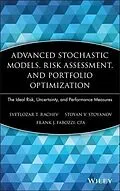This groundbreaking book extends traditional approaches of risk measurement and portfolio optimization by combining distributional models with risk or performance measures into one framework. Throughout these pages, the expert authors explain the fundamentals of probability metrics, outline new approaches to portfolio optimization, and discuss a variety of essential risk measures. Using numerous examples, they illustrate a range of applications to optimal portfolio choice and risk theory, as well as applications to the area of computational finance that may be useful to financial engineers.
Autorentext
Svetlozar T. Rachev, PhD, Doctor of Science, is
Chair-Professor at the University of Karlsruhe in the School of
Economics and Business Engineering; Professor Emeritus at the
University of California, Santa Barbara; and Chief-Scientist of
FinAnalytica Inc.
Stoyan V. Stoyanov, PhD, is the Chief Financial
Researcher at FinAnalytica Inc.
Frank J. Fabozzi, PhD, CFA, is Professor in the Practice
of Finance and Becton Fellow at Yale University's School of
Management and the Editor of the Journal of Portfolio
Management.
Klappentext
Advanced Stochastic Models, Risk Assessment, and Portfolio Optimization
The finance industry is seeing increased interest in new risk measures and techniques for portfolio optimization when parameters of the model are uncertain.
This groundbreaking book extends traditional approaches of risk measurement and portfolio optimization by combining distributional models with risk or performance measures into one framework. Throughout these pages, the expert authors explain the fundamentals of probability metrics, outline new approaches to portfolio optimization, and discuss a variety of essential risk measures. Using numerous examples, they illustrate a range of applications to optimal portfolio choice and risk theory, as well as applications to the area of computational finance that may be useful to financial engineers. They also clearly show how stochastic models, risk assessment, and optimization are essential to mastering risk, uncertainty, and performance measurement.
Advanced Stochastic Models, Risk Assessment, and Portfolio Optimization provides quantitative portfolio managers (including hedge fund managers), financial engineers, consultants, and academic researchers with answers to the key question of which risk measure is best for any given problem.
Inhalt
Preface xiii
Acknowledgments xv
About the Authors xvii
CHAPTER 1 Concepts of Probability 1
1.1 Introduction 1
1.2 Basic Concepts 2
1.3 Discrete Probability Distributions 2
1.3.1 Bernoulli Distribution 3
1.3.2 Binomial Distribution 3
1.3.3 Poisson Distribution 4
1.4 Continuous Probability Distributions 5
1.4.1 Probability Distribution Function, Probability Density Function, and Cumulative Distribution Function 5
1.4.2 The Normal Distribution 8
1.4.3 Exponential Distribution 10
1.4.4 Student's t-distribution 11
1.4.5 Extreme Value Distribution 12
1.4.6 Generalized Extreme Value Distribution 12
1.5 Statistical Moments and Quantiles 13
1.5.1 Location 13
1.5.2 Dispersion 13
1.5.3 Asymmetry 13
1.5.4 Concentration in Tails 14
1.5.5 Statistical Moments 14
1.5.6 Quantiles 16
1.5.7 Sample Moments 16
1.6 Joint Probability Distributions 17
1.6.1 Conditional Probability 18
1.6.2 Definition of Joint Probability Distributions 19
1.6.3 Marginal Distributions 19
1.6.4 Dependence of Random Variables 20
1.6.5 Covariance and Correlation 20
1.6.6 Multivariate Normal Distribution 21
1.6.7 Elliptical Distributions 23
1.6.8 Copula Functions 25
1.7 Probabilistic Inequalities 30
1.7.1 Chebyshev's Inequality 30
1.7.2 Fr´echet-Hoeffding Inequality 31
1.8 Summary 32
CHAPTER 2 Optimization 35
2.1 Introduction 35
2.2 Unconstrained Optimization 36
2.2.1 Minima and Maxima of a Differentiable Function 37
2.2.2 Convex Functions 40
2.2.3 Quasiconvex Functions 46
2.3 Constrained Optimization 48
2.3.1 Lagrange Multipliers 49
2.3.2 Convex Programming 52
2.3.3 Linear Programming 55
2.3.4 Quadratic Programming 57
2.4 Summary 58
CHAPTER 3 Probability Metrics 61
3.1 Introduction 61
3.2 Measuring Distances: The Discrete Case 62
3.2.1 Sets of Characteristics 63
3.2.2 Distribution Functions 64
3.2.3 Joint Distribution 68
3.3 Primary, Simple, and Compound Metrics 72
3.3.1 Axiomatic Construction 73
3.3.2 Primary Metrics 74
3.3.3 Simple Metrics 75
3.3.4 Compound Metrics 84
3.3.5 Minimal and Maximal Metrics 86
3.4 Summary 90
3.5 Technical Appendix 90
3.5.1 Remarks on the Axiomatic Construction of Probability Metrics 91
3.5.2 Examples of Probability Distances 94
3.5.3 Minimal and Maximal Distances 99
CHAPTER 4 Ideal Probability Metrics 103
4.1 Introduction 103
4.2 The Classical Central Limit Theorem 105
4.2.1 The Binomial Approximation to the Normal Distribution 105
4.2.2 The General Case 112
4.2.3 Estimating the Distance from the Limit Distribution 118
4.3 The Generalized Central Limit Theorem 120
4.3.1 Stable Distributions 120
4.3.2 Modeling Financial Assets with Stable Distributions 122
4.4 Construction of Ideal Probability Metrics 124
4.4.1 Definition 125
4.4.2 Examples 126
4.5 Summary 131
4.6 Technical Appendix 131
4.6.1 The CLT Conditions 131
4.6.2 Remarks on Ideal Metrics 133
CHAPTER 5 Choice under Uncertainty 139
5.1 Introduction 139
5.2 Expected Utility Theory 141
5.2.1 St. Petersburg Paradox 141
5.2.2 The von NeumannMorgenstern Expected Utility Theory 143
5.2.3 Types of Utility Functions 145
5.3 Stochastic Dominance 147
5.3.1 First-Order Stochastic Dominance 148
5.3.2 Second-Order Stochastic Dominance 149
5.3.3 Rothschild-Stigl...
